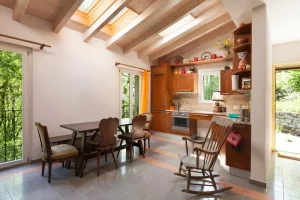Renovating your home while living in it can seem daunting, but with careful planning and preparation, it is possible to complete renovations smoothly while minimizing disruption to your daily routine.
This comprehensive guide covers key considerations and tips for successfully updating your space during occupancy.
Determine Your Goals and Priorities
Clearly defining your objectives and wish list for improvements upfront will provide focus and direction for the project.
- Take stock of your needs and budget. Be realistic about costs and how much you can take on. Focus first on repairs or upgrades that are essential for safety and livability.
- Prioritize changes that will have the biggest impact for resale value or quality of life. Kitchens and bathrooms may provide better return than less visible spaces.
- Involve all family members. Have discussions to ensure changes will meet everyone’s lifestyle needs and preferences. This can help manage expectations.
| Typical Priorities for Live-In Renovations:
– Electrical and plumbing repairs – Kitchen and bathroom updates – Flooring installation – Painting and wall repairs – Exterior upgrades like siding or roofing |
Having clear goals will make it easier to develop a workable plan and keep the project on track.
Plan the Logistics
Careful preparation and logistics planning are key to keeping your home functional for regular activities during the renovation process.
- Develop a detailed renovation schedule and timeline. Plan work in phases zone by zone to make living arrangements more manageable.
- Map out where you’ll sleep, cook, bathe as each area gets updated. You may need to set up a small temporary kitchen or bedroom.
- Create storage for furniture, appliances, and belongings removed from renovation areas via garage, attic, or rented units.
| Sample Live-In Renovation Schedule:
Phase 1 (Weeks 1-3): Master Suite Phase 2 (Weeks 4-7): Main Floor Phase 3 (Weeks 8-10): Secondary Bedrooms & Bathrooms |
Carefully staging work and logistics can keep projects on track with less daily disruption. Prepare for mess and inconvenience as best possible!
Prep the House

To control chaos and simplify contractor access, thoroughly clear and protect spaces before work begins.
- Box and remove items from closets, cabinets, shelves in zones being renovated. Cover and store safely.
- Protect existing surfaces with heavy drop cloths. Use a waterproof barrier for bathrooms.
- Photograph house pre-renovation including possessions for insurance records.
- Disconnect devices and utilities like ceiling fans or hardwired lighting before demolition.
| Supplies for Renovation Preparation:
– Moving boxes, crates, and containers – Furniture sliders or dollies – Heavy drop cloths and plastic sheeting – Painter’s tape – Label maker |
Proper prep work lets crews focus on renovations tasks instead of shuffling your belongings.
Create a Dust-Free Zone
One huge challenge is controlling debris, dust and dirt in your living spaces from the construction work.
- Seal off renovation areas behind plastic sheeting barriers. Use adhesive and painter’s tape for better adhesion.
- Set up portable air scrubbers or negative air machines with HEPA filters to catch particulates.
- Tape plastic tightly over vents, electrical outlets, cable ports and any gaps or cracks.
Maintaining positive room air pressure relative to construction zones helps block migration of dust particles. Consider adding a temporary HEPA filter covered doorway.
Hire Contractors
Securing a qualified and reliable house renovation team is crucial when work occurs in your home long-term.
- Vet and verify credentials of contractors. Look for demonstrated experience with occupied home renovations. Confirm active licensing and insurance.
- Conduct interviews to assess responsiveness, communication style and accessibility throughout projects.
- Outline scope of work, schedules, expectations in a detailed contractor agreement. Define cleanliness protocols.
- Coordinate work of electricians, plumbers and specialty crews needed. Discuss schedules for key items affecting occupancy like HVAC or plumbing system downtime.
| Questions to Ask Prospective Contractors:
– How will you isolate construction zones from living spaces? – How do you control dust, debris, and noise levels? – How will we coordinate access and work schedules? – What temporary provisions for utilities/facilities will be made? |
Carefully selecting your renovation pro team is well worth the investment. If you live in London, it is highly recommended that you hire the house renovation London team.
Live in a Construction Zone
Be mentally and logistically prepared to live for weeks or months in an active construction site.
- Cope with construction noises during approved work hours. Use earplugs and headphones to carve out quiet.
- Adjust wake times or schedules to give crews daytime access. Plan to clear or protect rooms and belongings every evening.
- Designate spaces to store materials, tools, protective gear overnight safely apart from your household items.
- Deal patiently with utility downtime for HVAC or appliances if needed.
- Manage parking and security with additional vehicles onsite long-term.
| Tips for Handling Life in a Construction Zone:
– Communicate clearly with contractors about needs and challenges. – Store essential items like medicines or special foods in occupied spaces. – Spend time away running errands, enjoying parks/cafes when it gets trying. – Celebrate milestones! Have progress photos marked on the calendar. |
While messy and frustrating at times, remind family members the discomfort is temporary but upgrades are forever!
Finish Strong

The final steps to completing your successful live-in renovation involve wrapping up details and celebrating!
- Build in buffers to schedule before move-in for final inspections, punch lists, cleanings and furniture move-in.
- Supervise contractors to repair any damage that occurred to possessions or existing house areas during the project.
- Celebrate finished renovations by enjoying renewed spaces with your family or hosting small housewarming.
- Learn for next time by documenting what worked well and where you’d improve.
| Keys to a Successful Live-In Renovation Finish: ✔ Allow 1-2 weeks for fixes, approvals before move-in ✔ Complete final thorough clean with contractors ✔ Verify all systems fully functional before contractors depart ✔ Secure any final certificates and lien releases |
With careful orchestration and patience through mess, you can achieve major home upgrades even while living onsite!







